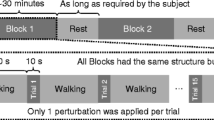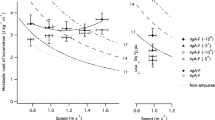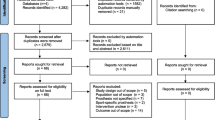Abstract
Background
Turning gait is an integral part of daily ambulation and likely poses a greater challenge for patients with transtibial amputation compared with walking a straight pathway. A torsion adapter is a prosthetic component that can increase transverse plane compliance of the prosthesis and decrease the torque applied to the residual limb, but whether this will improve patients’ mobility, pain, and fatigue remains unknown.
Questions/purposes
Does prescription of a torsion adapter translate to improvements in (1) functional mobility and (2) self-perceived pain and fatigue in moderately active patients with lower limb amputation?
Methods
Ten unilateral transtibial amputees wore a torsion or rigid adapter in random order. Functional mobility was assessed through a field measurement using an activity monitor and through a laboratory measurement using a 6-minute walk test that included turns. The residual limb pain grade assessed self-perceived pain and the Multidimensional Fatigue Inventory assessed fatigue.
Results
We found relatively small functional differences for amputees wearing a torsion adapter versus a rigid adapter. Amputees wearing a torsion adapter tended to take more low- and medium-intensity steps per day (331 ± 365 and 437 ± 511 difference in steps; effect size = 0.44 and 0.17; confidence interval [CI], 70–592 and 71–802; p = 0.019 and 0.024, respectively). They also experienced less pain interference with activities (1.9 ± 1.7 change in score; effect size = 0.83; CI, 0.3–3.4; p = 0.026) when wearing a torsion adapter. However, these patients took a similar number of total steps per day, walked a comparable distance in 6 minutes, and reported similar residual limb pain and fatigue.
Conclusions
For a moderately active group of amputees, the torsion adapter did not translate to substantial improvements in functional mobility and self-perceived pain and fatigue. The small increases in low- and medium-intensity activities with less pain interference when wearing a torsion adapter provides evidence to support prescribing this device for amputees with difficulty navigating the household and community environments.
Level of Evidence
Level II, therapeutic study. See Instructions for Authors for a complete description of levels of evidence.

Similar content being viewed by others
References
Berge JS, Czerniecki JM, Klute GK. Efficacy of shock-absorbing versus rigid pylons for impact reduction in transtibial amputees based on laboratory, field, and outcome metrics. J Rehabil Res Dev. 2005;42:795–808.
Brandes M, Schomaker R, Mollenhoff G, Rosenbaum D. Quantity versus quality of gait and quality of life in patients with osteoarthritis. Gait Posture. 2008;28:74–79.
Camarri B, Eastwood PR, Cecins NM, Thompson PJ, Jenkins S. Six minute walk distance in healthy subjects aged 55–75 years. Respir Med. 2006;100:658–665.
Chetta A, Zanini A, Pisi G, Aiello M, Tzani P, Neri M, Olivieri D. Reference values for the 6-min walk test in healthy subjects 20–50 years old. Respir Med. 2006;100:1573–1578.
Cohen J. Statistical Power Analysis for the Behavioral Sciences. Hillsdale, NJ, USA: L. Erlbaum Associates; 1988.
Coleman KL, Smith DG, Boone DA, Joseph AW, del Aguila MA. Step activity monitor: long-term, continuous recording of ambulatory function. J Rehabil Res Dev. 1999;36:8–18.
Cumming RG, Klineberg RJ. Fall frequency and characteristics and the risk of hip fractures. J Am Geriatr Soc. 1994;42:774–778.
Dite W, Temple VA. Development of a clinical measure of turning for older adults. Am J Phys Med Rehabil. 2002;81:857–866; quiz 867–868.
Dworkin RH, Turk DC, Farrar JT, Haythornthwaite JA, Jensen MP, Katz NP, Kerns RD, Stucki G, Allen RR, Bellamy N, Carr DB, Chandler J, Cowan P, Dionne R, Galer BS, Hertz S, Jadad AR, Kramer LD, Manning DC, Martin S, McCormick CG, McDermott MP, McGrath P, Quessy S, Rappaport BA, Robbins W, Robinson JP, Rothman M, Royal MA, Simon L, Stauffer JW, Stein W, Tollett J, Wernicke J, Witter J. Core outcome measures for chronic pain clinical trials: IMMPACT recommendations. Pain. 2005;113:9–19.
Dworkin RH, Turk DC, Wyrwich KW, Beaton D, Cleeland CS, Farrar JT, Haythornthwaite JA, Jensen MP, Kerns RD, Ader DN, Brandenburg N, Burke LB, Cella D, Chandler J, Cowan P, Dimitrova R, Dionne R, Hertz S, Jadad AR, Katz NP, Kehlet H, Kramer LD, Manning DC, McCormick C, McDermott MP, McQuay HJ, Patel S, Porter L, Quessy S, Rappaport BA, Rauschkolb C, Revicki DA, Rothman M, Schmader KE, Stacey BR, Stauffer JW, von Stein T, White RE, Witter J, Zavisic S. Interpreting the clinical importance of treatment outcomes in chronic pain clinical trials: IMMPACT recommendations. J Pain. 2008;9:105–121.
Ehde DM, Czerniecki JM, Smith DG, Campbell KM, Edwards WT, Jensen MP, Robinson LR. Chronic phantom sensations, phantom pain, residual limb pain, and other regional pain after lower limb amputation. Arch Phys Med Rehabil. 2000;81:1039–1044.
English RD, Hubbard WA, McElroy GK. Establishment of consistent gait after fitting of new components. J Rehabil Res Dev. 1995;32:32–35.
Ephraim PL, Wegener ST, MacKenzie EJ, Dillingham TR, Pezzin LE. Phantom pain, residual limb pain, and back pain in amputees: results of a national survey. Arch Phys Med Rehabil. 2005;86:1910–1919.
Gailey RS, Roach KE, Applegate EB, Cho B, Cunniffe B, Licht S, Maguire M, Nash MS. The amputee mobility predictor: an instrument to assess determinants of the lower-limb amputee’s ability to ambulate. Arch Phys Med Rehabil. 2002;83:613–627.
Glaister BC, Bernatz GC, Klute GK, Orendurff MS. Video task analysis of turning during activities of daily living. Gait Posture. 2007;25:289–294.
Guyatt GH, Townsend M, Berman LB, Keller JL. A comparison of Likert and visual analogue scales for measuring change in function. J Chronic Dis. 1987;40:1129–1133.
Hartsell H, Fitzpatrick D, Brand R, Frantz R, Saltzman C. Accuracy of a custom-designed activity monitor: implications for diabetic foot ulcer healing. J Rehabil Res Dev. 2002;39:395–400.
Hinz A, Fleischer M, Brahler E, Wirtz H, Bosse-Henck A. Fatigue in patients with sarcoidosis, compared with the general population. Gen Hosp Psychiatry. 2011;33:462–468.
Jayakaran P, Johnson GM, Sullivan SJ. Turning performance in persons with a dysvascular transtibial amputation. Prosthet Orthot Int. 2014;38:75–78.
Klute GK, Berge JS, Orendurff MS, Williams RM, Czerniecki JM. Prosthetic intervention effects on activity of lower-extremity amputees. Arch Phys Med Rehabil. 2006;87:717–722.
Lamoureux LW, Radcliffe CW. Functional analysis of the UC-BL shank axial rotation device. Prosthet Orthot Int. 1977;1:114–118.
Lee KA, Hicks G, Ninomurcia G. Validity and reliability of a scale to assess fatigue. Psychiatr Res. 1991;36:291–298.
Lin SJ, Bose NH. Six-minute walk test in persons with transtibial amputation. Arch Phys Med Rehabil. 2008;89:2354–2359.
Lord SR, Menz HB. Physiologic, psychologic, and health predictors of 6-minute walk performance in older people. Arch Phys Med Rehabil. 2002;83:907–911.
McDonald CM, Widman L, Abresch RT, Walsh SA, Walsh DD. Utility of a step activity monitor for the measurement of daily ambulatory activity in children. Arch Phys Med Rehabil. 2005;86:793–801.
Miller MD, Ferris DG. Measurement of subjective phenomena in primary care research: the Visual Analogue Scale. Fam Pract Res J. 1993;13:15–24.
Orendurff MS, Segal AD, Berge JS, Flick KC, Spanier D, Klute GK. The kinematics and kinetics of turning: limb asymmetries associated with walking a circular path. Gait Posture. 2006;23:106–111.
Scott J, Huskisson EC. Graphic representation of pain. Pain. 1976;2:175–184.
Segal AD, Orendurff MS, Czerniecki JM, Shofer JB, Klute GK. Transtibial amputee joint rotation moments during straight-line walking and a common turning task with and without a torsion adapter. J Rehabil Res Dev. 2009;46:375–383.
Smets EM, Garssen B, Bonke B, De Haes JC. The Multidimensional Fatigue Inventory (MFI) psychometric qualities of an instrument to assess fatigue. J Psychosom Res. 1995;39:315–325.
Smets EM, Garssen B, Cull A, de Haes JC. Application of the multidimensional fatigue inventory (MFI-20) in cancer patients receiving radiotherapy. Br J Cancer. 1996;73:241–245.
Smith DG, Ehde DM, Hanley MA, Campbell KM, Jensen MP, Hoffman AJ, Awan AB, Czerniecki JM, Robinson LR. Efficacy of gabapentin in treating chronic phantom limb and residual limb pain. J Rehabil Res Dev. 2005;42:645–654.
Stepien JM, Cavenett S, Taylor L, Crotty M. Activity levels among lower-limb amputees: self-report versus step activity monitor. Arch Phys Med Rehabil. 2007;88:896–900.
Thigpen MT, Light KE, Creel GL, Flynn SM. Turning difficulty characteristics of adults aged 65 years or older. Phys Ther. 2000;80:1174–1187.
Tudor-Locke C, Bassett DR Jr. How many steps/day are enough? Preliminary pedometer indices for public health. Sports Med. 2004;34:1–8.
Von Korff M, Ormel J, Keefe FJ, Dworkin SF. Grading the severity of chronic pain. Pain. 1992;50:133–149.
Wall JC, Bell C, Campbell S, Davis J. The Timed Get-up-and-Go test revisited: measurement of the component tasks. J Rehabil Res Dev. 2000;37:109–113.
Acknowledgments
We thank Jane B. Shofer MS, for performing the statistical analysis and Wayne Biggs CPO, for the prosthetic adjustments.
Author information
Authors and Affiliations
Corresponding author
Additional information
The institution of the authors has received funding from the Department of Veterans Affairs, Rehabilitation Research and Development Service, grants A3611I and A9243C.
All ICMJE Conflict of Interest Forms for authors and Clinical Orthopaedics and Related Research editors and board members are on file with the publication and can be viewed on request.
Clinical Orthopaedics and Related Research neither advocates nor endorses the use of any treatment, drug, or device. Readers are encouraged to always seek additional information, including FDA approval status, of any drug or device before clinical use.
Each author certifies that his or her institution approved the human protocol for this investigation, that all investigations were conducted in conformity with ethical principles of research, and that informed consent for participation in the study was obtained.
This work was performed at the Veterans Affairs Puget Sound Health Care System, Seattle, WA, USA.
About this article
Cite this article
Segal, A.D., Kracht, R. & Klute, G.K. Does a Torsion Adapter Improve Functional Mobility, Pain, and Fatigue in Patients with Transtibial Amputation?. Clin Orthop Relat Res 472, 3085–3092 (2014). https://doi.org/10.1007/s11999-014-3607-9
Published:
Issue Date:
DOI: https://doi.org/10.1007/s11999-014-3607-9




